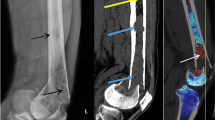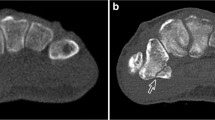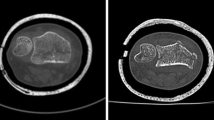Abstract
Objectives
Bone marrow edema (BME) from dual-energy CT is useful to direct attention to radiographically occult fractures. The aim was to characterize utility of BME of lower extremity (LE) fractures with the hypothesis that stabilized and post-acute fractures exhibit decreased extent and frequency of BME than non-stabilized and acute fractures, respectively.
Methods
An IRB-approved retrospective review of known LE fractures. A total of 141 cases met inclusion criteria, including 82 fractures without splint/cast stabilization, and 59 cases with stabilization. Two readers independently recorded BME, and its multiplicity and area (mm2). A separate reader assessed fracture location, comminution, and chronicity. Wilcoxon rank sum test, multiple regression, intraclass correlation (ICC), kappa statistics, and chi-square tests were used.
Results
BME was significantly larger in non-stabilized (859.3 mm2 (420.6–1451.8)) than stabilized fractures (493.5 mm2 (288.8–883.2)), p = .011). Comminuted (p = 0.006), non-stabilized (p = 0.0004), and acute fractures (p = 0.036) were all associated with larger BME area. BME presence had excellent results for both stabilized (Cohen’s Kappa = 0.81) and non-stabilized fractures (Cohen’s Kappa = 0.84). ICC for BME area showed excellent correlation for both stabilized (ICC = 0.78) and non-stabilized groups (ICC = 0.86). BME multiplicity showed excellent agreement for stabilized (ICC = 0.81) and good agreement for non-stabilized (ICC = 0.67) fractures. Lastly, stabilized cases showed increased multiplicity of BME compared to non-stabilized fractures (p < 0.001).
Conclusions
BME evaluation can assist in differentiation of acute versus post-acute fractures. Extent of BME is reduced with splint/cast stabilization, which may limit its accuracy in detection of lower extremity fractures.
Key Points
• Evaluation of bone marrow edema on dual-energy CT aids in differentiation of acute versus post-acute fracture.
• Bone marrow edema evaluation is limited in the setting of post-acute or stabilized fractures.
• There is decreased frequency and extent of bone marrow edema in post-acute, non-comminuted, and stabilized fractures.






Similar content being viewed by others
Abbreviations
- BME:
-
Bone marrow edema
- DECT:
-
Dual-energy computed tomography
- EMR:
-
Electronic medical records
- HIPAA:
-
Health Insurance Portability and Accountability Act
- ICC:
-
Intraclass correlation
- IRB:
-
Institutional review board
- LE:
-
Lower extremity
- mm:
-
Millimeter
- MSK:
-
Musculoskeletal
- ORIF:
-
Open reduction and internal fixation
- PACS:
-
Picture Archiving and Communications System
- XR:
-
X-ray
References
Pollak AN W-CS. The burden of musculoskeletal diseases in the United States 2014. Fracture Trends. 2014 [cited 2021 1 October 2019]. Available from: https://www.boneandjointburden.org/2014-report/via23/fracture-trends
Tosteson ANA (1999) Chapter 2 - economic impact of fractures. In: Orwoll ES (ed) Osteoporosis in Men. Academic Press, San Diego, pp 15–27
Galluzzo M, Greco F, Pietragalla M et al (2018) Calcaneal fractures: radiological and CT evaluation and classification systems. Acta Biomed 89(1-s):138–150
Avci M, Kozaci N (2019) Comparison of X-ray imaging and computed tomography scan in the evaluation of knee trauma. Medicina (Kaunas) 55(10):623
Friedl W, Gradl G (2019) Nailing of lower extremity fractures. Injury. 50:1–3
Gheorghita A, Webster F, Thielke S et al (2018) Long-term experiences of pain after a fragility fracture. Osteoporos Int 29(5):1093–1104
Akhavan S, Martinkovich SC, Kasik C et al (2020) Bone marrow edema, clinical significance, and treatment options: a review. J Am Acad Orthop Surg 28(20):e888–e899
Narayanan A, Dettori N, Chalian M et al (2021) Dual-energy CT-generated bone marrow oedema maps improve timely visualisation and recognition of acute lower extremity fractures. Clin Radiol 76(9):710 e9–710 e14
Suh CH, Yun SJ, Jin W et al (2018) Diagnostic performance of dual-energy CT for the detection of bone marrow oedema: a systematic review and meta-analysis. Eur Radiol 28(10):4182–4194
Foti G, Beltramello A, Catania M et al (2019) Diagnostic accuracy of dual-energy CT and virtual non-calcium techniques to evaluate bone marrow edema in vertebral compression fractures. Radiol Med 124(6):487–494
Knight KL (2008) More precise classification of orthopaedic injury types and treatment will improve patient care. J Athl Train 43(2):117–118
Hemmann P, Friederich M, Körner D et al (2021) Changing epidemiology of lower extremity fractures in adults over a 15-year period - a National Hospital Discharge Registry study. BMC Musculoskelet Disord 22(1):456
Pallin DJ, Espinola JA, Camargo CA Jr (2014) US population aging and demand for inpatient services. J Hosp Med 9(3):193–196
Kessler J, Koebnick C, Smith N et al (2013) Childhood obesity is associated with increased risk of most lower extremity fractures. Clin Orthop Relat Res 471(4):1199–1207
Saba L, De Filippo M, Saba F et al (2019) Dual energy CT and research of the bone marrow edema: comparison with MRI imaging. Indian J Radiol Imaging 29(4):386–390
Lubovsky O, Liebergall M, Mattan Y et al (2005) Early diagnosis of occult hip fractures MRI versus CT scan. Injury. 36(6):788–792
Wright AA, Hegedus EJ, Lenchik L et al (2016) Diagnostic accuracy of various imaging modalities for suspected lower extremity stress fractures: a systematic review with evidence-based recommendations for clinical practice. Am J Sports Med 44(1):255–263
Sadineni RT, Pasumarthy A, Bellapa NC et al (2015) Imaging patterns in MRI in recent bone injuries following negative or inconclusive plain radiographs. J Clin Diagn Res 9(10):TC10–TC13
Cavallaro M, D'Angelo T, Albrecht MH et al (2022) Comprehensive comparison of dual-energy computed tomography and magnetic resonance imaging for the assessment of bone marrow edema and fracture lines in acute vertebral fractures. Eur Radiol 32(1):561–571
Gosangi B, Mandell JC, Weaver MJ et al (2020) Bone marrow edema at dual-energy CT: a game changer in the emergency department. Radiographics 40(3):859–874
Ai S, Qu M, Glazebrook KN, Liu Y et al (2014) Use of dual-energy CT and virtual non-calcium techniques to evaluate post-traumatic bone bruises in knees in the subacute setting. Skeletal Radiol 43(9):1289–1295. https://doi.org/10.1007/s00256-014-1913-7 Epub 2014 Jun 10
Zhang Y, Qi H, Zhang Y, Wang J, Xue J (2021) Vertebral bone marrow edema in magnetic resonance imaging correlates with bone healing histomorphometry in (sub)acute osteoporotic vertebral compression fracture. Eur Spine J 30(9):2708–2717. https://doi.org/10.1007/s00586-021-06814-3 Epub 2021 Mar 20
Funding
The authors state that this work has not received any funding.
Author information
Authors and Affiliations
Corresponding author
Ethics declarations
Guarantor
The scientific guarantor of this publication is Dr. Avneesh Chhabra (MD, MBA).
Conflict of interest
The authors of this manuscript declare relationships with the following companies:
AC serves as a consultant for ICON Medical and Treace Medical Concepts, Inc. AC also receives royalties from Jaypee and Wolters. AC is a medical advisor and received research grant from ImageBiopsy Lab Inc.
The remaining authors do not report any relationships with any companies.
Statistics and biometry
One of the authors has significant statistical expertise.
Informed consent
Written informed consent was waived by the Institutional Review Board.
Ethical approval
Institutional Review Board approval was obtained.
Methodology
• retrospective
• cross-sectional study
• performed at one institution
Additional information
Publisher’s note
Springer Nature remains neutral with regard to jurisdictional claims in published maps and institutional affiliations.
Rights and permissions
Springer Nature or its licensor (e.g. a society or other partner) holds exclusive rights to this article under a publishing agreement with the author(s) or other rightsholder(s); author self-archiving of the accepted manuscript version of this article is solely governed by the terms of such publishing agreement and applicable law.
About this article
Cite this article
Haider, S., Pezeshk, P., Xi, Y. et al. Extent of bone marrow edema on dual-energy CT aids in differentiation of acute from post-acute fractures of lower legs. Eur Radiol 33, 4094–4102 (2023). https://doi.org/10.1007/s00330-022-09373-3
Received:
Revised:
Accepted:
Published:
Issue Date:
DOI: https://doi.org/10.1007/s00330-022-09373-3




